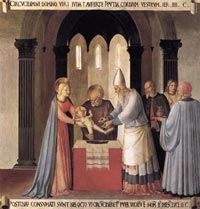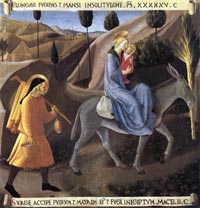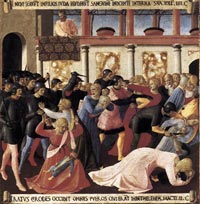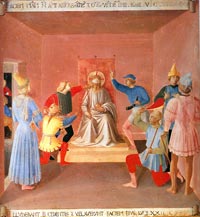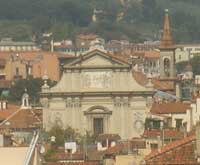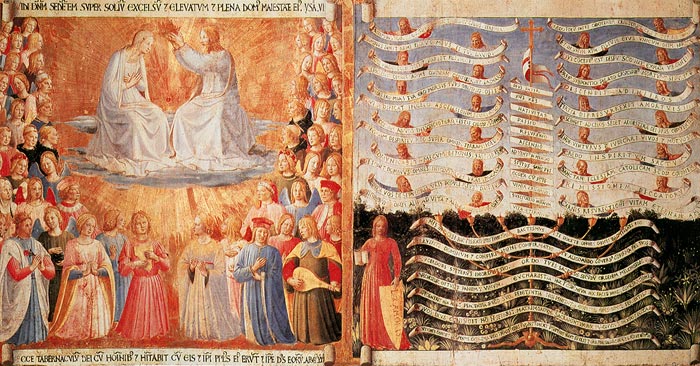 |
|
Fra Angelico, Armadio degli Argenti: Coronation of the Virgin and Lex Amoris, about 1450, Florence, Museo di San Marco |
|
Fra Angelico | Paintings for the Armadio degli Argenti (1451-52) |
| In 1448, according to an early chronicle, Fra Angelico received from Piero de Medici, Cosimos son, the prestigious assignment to decorate the doors of a silver treasury for the new oratory to be constructed near the chapel of the Santissima Annunziata in the church of the same name. Fra Angelico did not begin work on this extensive series of small paintings until after his return from Rome in 1449/50. The silver treasury panels were the last major commission undertaken by Fra Angelico and he was evidently unable to bring the project to completion before he was called back to Rome, where he died in February 1455.[1] The Armadio degli Argenti (Silver Chest) may have been the most visible of the friar's work by virtue of the site for which it was made. Santissima Annunziata was the motherhouse of the Servites, founded by St Filippo Benizzi (c. 1233-1285), the only religious order that originated in Florence. The sacrality of the church was augmented further when, as legend recounted, an angel completed the fresco of the Annunciation in 1252. By the early fifteenth century, the Annunciation had become the centre of a major cult, receiving donations of precious silver. In the late 1440s, Michelozzo renovated Santissima Annunziata at the behest of Piero de' Medici to accommodate the throngs of worshippers who flocked to behold the sacred image. To safeguard the silver offerings to the Annunciation, Piero commissioned a wooden cabinet, the movable shutters of which Fra Angelico painted. The original appearance of this monumental cabinet is not known. lts purpose was to keep safe and to display the precious ex votos that grateful worshipers donated to the miraculous shrine of the Santissima Annunziata. The program, which is entitled Lex Amoris, (the Law of Love) on its last panel, seems to have required Fra Angelico to execute as many as forty small scenes. Thirty-two of these scenes by Fra Angelica and his assistants have come down to us on three large panels containing nine, twelve, and eleven scenes respectively. A fourth panel contains three episodes by Alessio Baldovinetti, who was evidently called upon to fill in a lacuna. The title Lex Amoris refers to a doctrine of Saint Thomas Aquinas that is elaborated in these paintings by allegory and inscription: Christ did not come to me to destroy the old laws of the patriarchs, but to renew and complete them with a new law of love. |
|
||
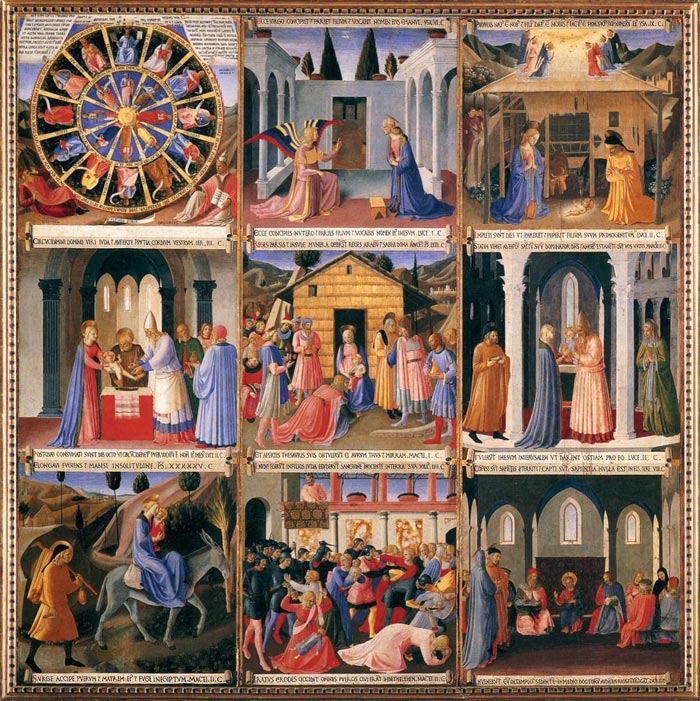 |
||
Fra Angelico, Armadio degli Argenti, Scenes from the Life of Christ, 1451-52, tempera on panel, 123 x 160 cm, Museo di San Marco, Florence |
||
The scenes on this panel are Mystic Wheel, Annunciation, Nativity, Circumcision, Adoration of the Magi, Presentation at the Temple, Flight into Egypt, Massacre of the Innocents and Christ among the Doctors. Latin texts from the Old and New testaments are inscribed on scrolls unfurled above and below the episodes. They were added later, not by Angelico, when all of the scenes were complete. The series begins with the Vision of Ezekiel or the Mystical Wheel, in which the twelve Hebrew patriarchs and prophets are represented in the outer ring, which encloses the inner wheel with the eight authors of the New Testament: the Four Evangelists and Saints Paul, James, Jude. and Peter. The inscription from Genesis on the outer circle of the wheel describes the creation of the world, while, on the inner ring, the Incipit from the Gospel of John relates the new creation - the Incarnation of the Word of God. Each of the scenes from the life of Christ is framed on top by an Old Testament prophesy and below by a text from the New Testament in which the prophesy is fulfilled. The series concludes, as it begins, with an entirely literary panel. Scrolls with prophecies and texts are arranged, extraordinarily, in the shape of the seven-branched candelabra (menorah) of Jewish origin. The purpose of this superabundance of literary citations is clearly didactic: the Silver Treasury panels were destined to serve a large public as a kind of illustrated Bible, complete with all relevant texts. In 1450, on the eve of the invention of movable type, relatively few people possessed their own bibles. |
||
|
||
| This panel is part of a series, now consisting of thirty-five panels, commissioned by Piero de Medici for the doors of a cupboard at the San Marco convent, and depicting scenes from the life of Christ.
In this, the first panel, the prophet Ezekiel and St Gregory the Great sit in a mountainous landscape with the river Chobar running between them. In the top left of the panel is a text from the first book of Ezekiel outlining the prophet's vision, which is shown below. Ezekiel leans back, his hands raised in surprise. His vision included four animalia who, 'had one likeness: and their appearance and their work was as it were a wheel in the middle of a wheel', (Ezekiel 1, v. 16). It is this wheel within a wheel which is shown here with a flaming circumference. Angelico depicts the wheel as being made of two concentric circles. Around the larger wheel is the account of the creation from Genesis, and around the smaller the first three verses of the Gospel of St. John, 'In the beginning was the Word, and the Word was with God, and the word was God ...', which echo the words from Genesis. |
||
| Although the themes and settings of the scenes are varied, Angelico united the ensemble with consistently scaled figures, architecture and horizons. The Annunciation takes place within a deep, open courtyard framed by twin porticos, inspired by the architecture of the church. Throughout the cycle, parallel and prophetic texts amplify the resonance of every scene. In the Annunciation, the quotations from the Book of Isaiah and the Gospel of Luke are virtually identical in phrasing, confirming, according to Christian exegesis, that Isaiah's prophecy was fulfilled through the Incarnation and divinely ordered. |
|
|
| Although all of the surviving scenes were designed by Fra Angelico (apart from chose by Baldovinetti), the artist's own hand is observable only in the first large panel of the series, illustrated here in color. The autograph scenes by Fra Angelico show no signs of waning powers or declining creativity. The Nativity is a superb redaction in the artist's last style of his earlier treatments of this favorite theme in paintings in Forlì and at San Marco (cell 5). Joseph's golden robes are illuminated as if the radiant infant were a candle in the darkness; directly above chem, a host of angels bask in the effulgence of the Incarnate Deity. The scene is framed above by a text from Isaiah (9:6), "For unto us a child is born, unto us a son is given" and below by Saint Luke (2:6-7),"The days were accomplished that she should be delivered, and she brought forth her firstborn son." During the fortnight between Christmas and Epiphany, the dilapidated stables in Bethlehem seem to have received a much needed refurbishing, just in time for the arrival of the three wise men. |
Nativity, 1451-52, Museo di San Marco, Florence | |
| In the Temple, Christ is presented for circumcision. The table takes centre stage and its receding top leads the eye back to the choir. The forms of the three figures in the foreground are echoed in the background by the three arched walls of the choir and their windows. The chiefly vertical fall of the draperies of all the figures is painted with great discrimination, and echoes the fluting of the pilasters. |
||
| Fra Angelica's own hand is evidenced in several fine heads of the participants in the Adoration of the Magi, a panel that has undoubtedly suffered considerable damage in the past. The kneeling king in the foreground recalls the corresponding Magus in the predella of the Linaiuoli Tabernacle of 1433, although this later composition is altogether more disciplined and coherent. The Old Testament prophesy, above, is taken from verse 10 of Psalm 71 in the Vulgate:"The kings of Tharsis and the islands shall offer presents: the kings of the Arabians and of Saba shall bring gifts." The historical fulfillment of this text is related by Saint Matthew (2:11), 'And they opened their treasures and presented unto him gifts of gold, frankincense, and myrrh:' The use of paired inscriptions is moreover an appropriate allusion to the Annunciate Virgin, whom Thomas Aquinas described as the point of convergence between the Old and the New Testaments. |
||
| This scene shows the continuing influence on Angelico of naturalism. Having been warned in a dream, Joseph, Mary and the infant Christ make their escape from Herod's massacres by going into Egypt. Behind them a series of trees of diminishing size plots out the perspective of the landscape. The Holy Family is lit by a strong light from the left, the Virgin's draperies carefully delineated so as to show the position of both her legs as she rides side-saddle on the donkey. As in The Circumcision her halo is depicted as a three-dimensional object, which can both turn in space and reflect light. It was only late in his career as a painter that Angelico began to develop the spatial properties of the nimbus. | ||
| Herod, with crown and sceptre, watches from above the infanticide he has ordained. The sinister, dark-clad soldiers pour through the archway wielding black daggers against the children. The mothers, shown in a great variety of terrified postures and with looks of horror, attempt to protect their infants, but to no avail. Art in Tuscany | The Massacre of the Innocents |
||
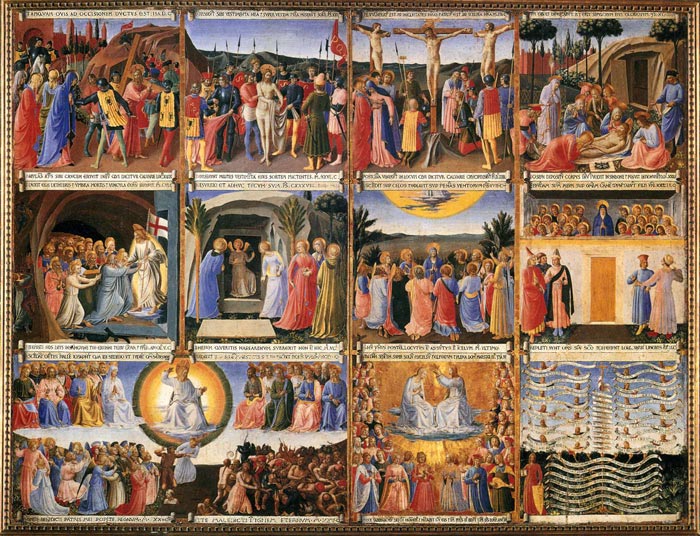 |
||
Fra Angelico, Armadio degli Argenti, Scenes from the Life of Christ, 1451-52, tempera on panel, 123 x 160 cm, Museo di San Marco, Florence |
||
| The scenes on this panel are Carrying the Cross, Derobing of Christ, Crucifixion, Deposition, Descent into Limbo, Pious Women at the Tomb, Ascension, Pentecost, Last Judgment, Coronation of the Virgin and 'Lex Amoris'. |
||
|
||
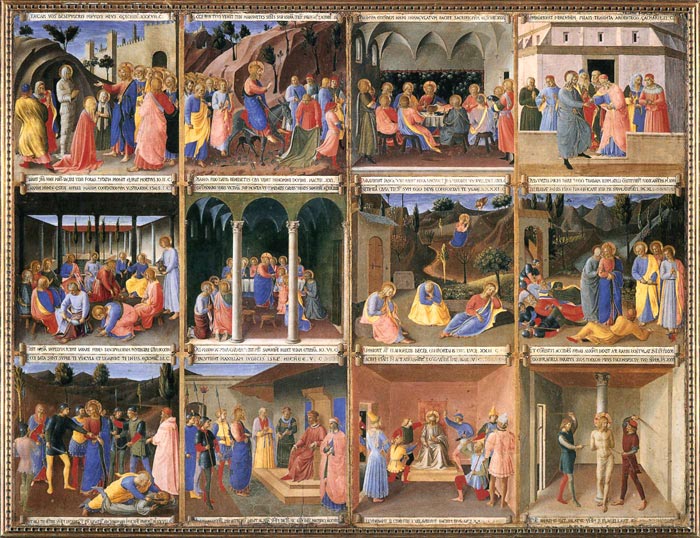 |
||
Fra Angelico, Armadio degli Argenti, Scenes from the Life of Christ, 1451-52, tempera on panel, 123 x 160 cm, Museo di San Marco, Florence |
||
| The scenes on this panel are Raising of Lazarus, Entry into Jerusalem, Last Supper, Payment of Judas, Washing of the Feet, Institution of the Eucharist, Prayer in the Garden, Judas's Betrayal, Capture of Christ, Christ before Caiafas, Mocking of Christ and Christ at the Column. | ||
|
||
|
||||
Podere Santa Pia, mystic holiday home in the heart of the Tuscan Maremma
|
Casa Vacanze Podere Santa Pia, Castiglioncello Bandini, Toscane
|
Colline sotto Podere Santa Pia con ampia vista sulla Maremma Grossetana
|
||
| |
|
|||
Pools in a natural area, a dive into the heart of Tuscany
|
A beautiful spring morning by the pool, a natural jewel nestled amidst the verdant Tuscan hill
|
The night pool at Podere Santa Pia exudes a hypnotic sense of purity
|
||
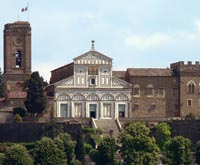 |
||||
Florence, San Miniato al Monte |
Florence, Duomo |
Siena, duomo |
||
Fra Angelico in Palazzo Strozzi en Museo San Marco
The exhibition Beato Angelico at Palazzo Strozzi and the Museo San Marco explores the work, development, and influence of Beato Angelico's art, as well as his relationships with painters such as Lorenzo Monaco, Masaccio, Filippo Lippi, and sculptors like Lorenzo Ghiberti, Michelozzo, and Luca della Robbia. It is the first major exhibition in Florence dedicated to the artist exactly seventy years after the 1955 monograph. |
||||
| |
||||
Beato Angelico, veduta della mostra, sala 8, I Medici, Beato Angelico e Alesso Baldovinetti, Scene della vita di Cristo dall’Armadio degli Argenti, 1450-1452 circa, Palazzo Strozzi, Firenze, 2025 [Photo: Ela Bialkowska, OKNO Studio]
|
||||
 |
|
 |
||
Palazzo Strozzi, Firenze
|
Beato Angelico, mostra Palazzo Strozzi and Museo di San Marco, Firenze, 2025
|
Museo di San Marco, veduta posteriore
|
||
Beato Angelico, la grande mostra a Palazzo Strozzi, Firenze, sala 1
|
Beato Angelico, Pala della compagnia di San Francesco in Santa Croce (1428-1429) e Giudizio universale (1425-1428 circa), Museo di San Marco, Firenze
|
Beato Angelico, panoramica della mostra con la Pala d'altare di San Marco ( 1438-1442) e la Pala di Annalena (1445 circa), Palazzo Strozzi, Firenze, 2025
|
||
San Marco Museum |
||||
| The San Marco Museum occupies the oldest part of a Dominican monastery rebuilt by Michelozzo during the decade from 1436 to 1446 by appointment of Cosimo de' Medici the Elder. Michelozzo attempted to use as much as possible the walls of the old building to create a monastery whose rooms and layout are in line with completely modern criteria of functionality, still recognisable today. Overall, the building is a monumental complex with all the sobriety and elegance typical of Florentine Renaissance architecture. On the ground floor, the rooms formerly used for community life: the Hospice for the pilgrims next to the entrance, the Chapter Hall, the Washroom, the Refectory and the adjoining room used for the kitchen and other facilities; there is also a small 15th-century cloister, called Chiostro della Spesa, and a courtyard, the so-called Granary Courtyard. During this same period, the building was endowed with an extraordinary cycle of paintings by Fra Angelico who lived and lived in the monastery in 1387 and 1400-1455. A number of the ground-floor rooms house a remarkable collection of panel paintings by Fra Angelico: particularly fine are the Last Judgement, the Linaioli Tabernacle, the Deposition, the Silver Wardrobe doors. The San Marco Museum also houses a number of works by Fra Bartolomeo (1472-1517), including a famous portrait of Savonarola. The Library, the first Renaissance library open to the public, formerly held the Italian, Latin and Greek codices that belonged to the Humanist, Niccolò Niccoli, which later passed to the Laurentian Library. It now holds a precious collection of over a hundred illuminated choir books from the Middle Ages and Renaissance, originating from this monastery and other suppressed monasteries and convents. San Marco Museum | www.firenzemusei.it Museo di San Marco Monday-Friday: 8.15-13.50; Saturday: 8.15-18.50; Sunday: 8.15-19.00 |
||||
The Church of Santa Maria Novella is one of the most important Gothic churches in Tuscany. The interior holds extraordinary works of art including Masaccio's Trinità, Ghirlandaio's fresco cycle in the Tornabuoni Chapel, Giotto's Crucifix, and the magnificent Cappellone degli Spagnoli (Spanish Chapel), frescoed by Andrea Bonaiuti and located in what on the west side of the nave. #travelingintuscany #poderesantapia
|
||||
This page incorporates text from the article Angelico, Fra by William Michael Rossetti, in the Encyclopædia Britannica, Eleventh Edition, a publication now in the public domain, and uses material from the Wikipedia articles Fra Angelico and San Marco Altarpiece published under the GNU Free Documentation License. |
||||

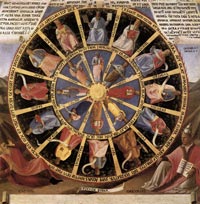
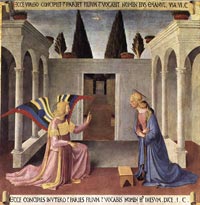 Annunciation, 1451-52, Museo di San Marco, Florence
Annunciation, 1451-52, Museo di San Marco, Florence